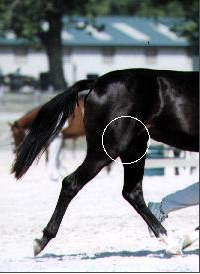EQUUS Consultants: The Strained Stifle in Horses
- March 10, 2017
- ⎯ Equus
QUESTION: My 4-year old Quarter Horse strained both her right and left stifle muscles. Both were extremely swollen in front of the patella and to the inside of the leg. I think she first hurt herself while barrel racing and then exacerbated the injury playfully bucking in the pasture. I put her on bute and used DMSO gel to get the inflammation down, and my veterinarian performed acupuncture a few days later. I also give my mare a MSM supplement.

Within three days the swelling went down about 40 percent. In the next three days, it went down to just a slight swelling, where it is now. Why did this injury occur? She is very muscular and in excellent shape and not overworked. While riding, I do exercises to strengthen her stifles, such as backing up. I have owned her since she was 3 months old and she has had no past injuries to her stifles. What else can I do to help her recover, and how can I prevent reinjury?
ANSWER:Without having seen your mare, I can only give you some general information about these sorts of injuries and you’ll have to decide what applies to your situation.
Muscle strain is uncommon in the general horse population. When muscle strains do occur they are usually found in horses who “work on their hocks,” such as cutting horses, reiners, barrel racers, polo ponies and high-level dressage horses. Of course, any horse who slips severely can strain muscles.
The muscular control of the horse’s stifle (the best analog of the human knee) is anatomically and functionally complex. We can reduce it, however, to three groups:
- the quadriceps (“quads”) on the front of the thigh, which extend the joint
- the hamstrings (“hams”) at the hock, which have two actions–to pull the stifle backward when the leg is on the ground or kicking and to bend the stifle when the leg is lifted
- the adductors on the inside of the thigh, which hold the leg under the body as it advances and prevent it from slipping sideways when the rump muscles pull on the hip joint or when the foot slips on a slick spot.
Your description of your mare’s injury implicates the quads and/or the adductors as the site of the strain, but without having seen your mare, I cannot be too specific.
You don’t specify if you treated the mare with bute and DMSO before or after your veterinarian first saw her; I hope it was after. The instinct to immediately treat a horse’s discomfort is common, but greatly complicates diagnosis. Drugs can sufficiently mask important details of an injury that the veterinarian should have to prevent worse outcomes. The six-day period you mention for the swelling to subside is about average for minor muscle injury that receives no treatment at all, so I doubt if the treatment your mare did receive was of much help in the process.
As to what happened to your filly on this occasion, I again must speculate. Muscle strains are most often due to one of several factors, including
- an unexpected/unguarded movement,
- insufficient skill, training or practice for the effort being attempted,
- inadequate conditioning and/or
- changes in the mechanics of exercise, such as a new shoes or a different rider.
The “excellent” shape you mention must be athletic, not merely aesthetic and the phrase “not overworked” is relative because barrel racing requires months of progressively harder and more challenging work to build up a horse’s tolerance to intense acceleration and turning. Keeping these factors in mind, you may be able to figure out approximately or exactly what happened.
The course since the injury suggests a good prognosis, given the appropriate adjustments in her training and use. Chances are, your mare won’t reinjure herself in this way again. If she does, get a veterinarian renowned in barrel circles to look right away, evaluate the whole horse and its use and give you a plan for dealing with the risks to your horse. Reprinted from the May, 2002 issue of EQUUS magazine





